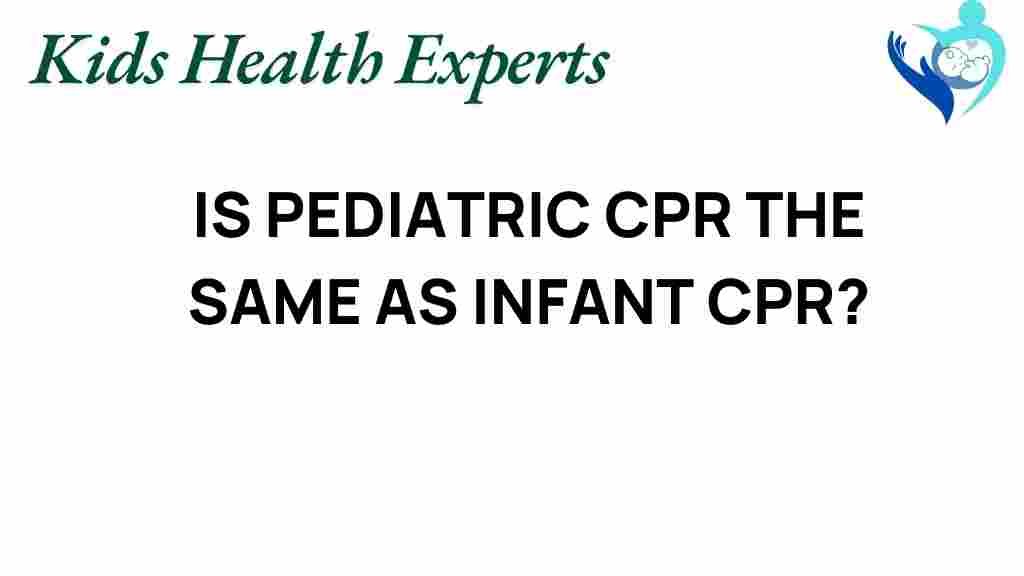Pediatric CPR vs. Infant CPR: What Every Caregiver Must Know
When it comes to child safety, understanding the differences between Pediatric CPR and Infant CPR is crucial for any caregiver. These lifesaving techniques can mean the difference between life and death in emergency situations. Whether you are a parent, babysitter, or anyone responsible for the care of young children, being equipped with the right knowledge and skills can help you respond effectively in emergencies. This article will delve into the specifics of Pediatric CPR and Infant CPR, offering essential guidelines, step-by-step processes, and troubleshooting tips for effective emergency response.
Understanding Pediatric CPR and Infant CPR
Pediatric CPR is designed for children aged 1 year to puberty, while Infant CPR is specifically for babies under 1 year old. It’s vital for caregivers to recognize the differences in anatomy, physiology, and potential emergencies that these age groups may face.
Key Differences Between Pediatric CPR and Infant CPR
- Age Group: Pediatric CPR is for children aged 1-12 years, whereas Infant CPR is for those under 1 year.
- Technique: The techniques differ in compression depth, frequency, and the method of delivering breaths.
- Size and Anatomy: Infants have smaller airways and require gentler techniques compared to older children.
Step-by-Step Guide to Pediatric CPR
Knowing the correct steps for Pediatric CPR can help you respond confidently in an emergency. Here’s how you can administer Pediatric CPR:
1. Assess the Situation
Before starting CPR, ensure the scene is safe. Check if the child is responsive by gently shaking their shoulders and asking if they are okay.
2. Call for Help
If the child is unresponsive and not breathing or only gasping, call emergency services immediately or ask someone else to do so. Be clear and concise about your location and the situation.
3. Position the Child
Lay the child on their back on a firm surface. If the child is breathing but unconscious, place them in the recovery position.
4. Check for Breathing
Look, listen, and feel for breathing for no more than 10 seconds. If the child is not breathing, proceed with CPR.
5. Start Chest Compressions
- Place the heel of one hand on the lower half of the child’s breastbone, and the other hand on top of the first.
- Keep your arms straight and use your body weight to compress the chest.
- Compress at a rate of 100-120 compressions per minute, allowing the chest to fully recoil between compressions.
- Compress the chest about 2 inches deep.
6. Deliver Rescue Breaths
- After every 30 compressions, give 2 rescue breaths.
- Seal your lips around the child’s mouth, pinch their nose shut, and give a breath that lasts about 1 second, enough to make the chest rise.
- Repeat this for a total of 2 breaths before continuing with chest compressions.
Step-by-Step Guide to Infant CPR
Infant CPR is slightly different due to the delicate nature of babies. Here’s how to perform Infant CPR:
1. Assess the Situation
Check if the infant is responsive by tapping their foot and speaking to them.
2. Call for Help
If the infant is unresponsive or not breathing, call emergency services immediately.
3. Position the Infant
Place the infant on their back on a firm, flat surface.
4. Check for Breathing
Look for signs of breathing for no more than 10 seconds. If the infant is not breathing, begin CPR.
5. Start Chest Compressions
- Use 2 fingers to compress the center of the infant’s chest just below the nipple line.
- Compress the chest about 1.5 inches deep at a rate of 100-120 compressions per minute.
6. Deliver Rescue Breaths
- After every 30 compressions, give 2 rescue breaths.
- Cover the infant’s mouth and nose with your mouth, creating a seal, and give a breath that lasts about 1 second.
- Ensure the chest rises with each breath.
Understanding CPR Guidelines
It is essential to stay updated on CPR guidelines. The American Heart Association provides the latest recommendations for CPR techniques. Caregivers should engage in regular training to maintain their skills and knowledge.
Training and Certification
Caregiver training for CPR is crucial. Here are some options:
- CPR Courses: Many organizations offer CPR certification courses that cover both Pediatric and Infant CPR.
- Online Training: Online resources and courses are available for flexible learning.
- Hands-On Practice: Practical experience through simulations is vital for confidence and skill retention.
Troubleshooting Tips During CPR
Even well-prepared caregivers may face challenges during an emergency. Here are some troubleshooting tips:
- Difficulty with Compressions: Ensure you are using the correct technique and body mechanics to apply adequate force.
- Rescue Breaths Not Effective: Check your seal and ensure the airway is open. Adjust the head position as necessary.
- Fatigue: If you become exhausted, ask someone to take over if help is available.
Conclusion
Understanding the differences between Pediatric CPR and Infant CPR is vital for every caregiver. By mastering these lifesaving techniques, you can greatly enhance child safety and be prepared for emergencies. Remember, regular practice and training are essential to ensure you can respond effectively in a crisis.
For more resources on CPR training and child safety, consider visiting the American Red Cross website for courses and certifications. Your proactive approach to learning about CPR can save lives!
To learn more about first aid and emergency response techniques, check out our detailed guide here.
This article is in the category Care and created by KidsHealthExperts Team
